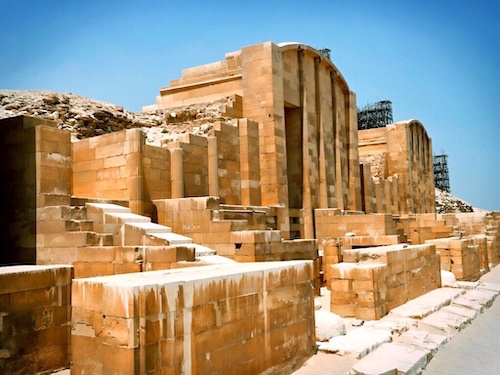
Heb Sed Hieroglyph
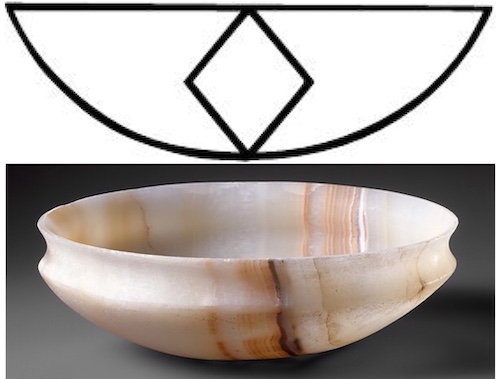
The heb glyph represents an alabaster bowl. These bowls were used for special purposes like festivals or feasts. In Egypt, craftsmen used alabaster for canopic jars and various other sacred and sepulchral objects. The ancients considered alabaster to be the best material in which to preserve their ointments. Alabaster was used for vessels dedicated for use in the cult of the deity Bast in the culture of the ancient Egyptians, and thousands of gypsum alabaster artifacts dating to the late 4th millennium BC also have been found in Tell Brak (present day Nagar), in Syria. In Egyptian religion the alabaster bowl was a sign of purification and renewal. I have included an exquisite example of an alabaster bowl from the Metropolitan Museum from the 4th-5th dynasty as an example. This sort of bowl would have been very valuable and probably only used for special occasions.



The frog was admired in ancient Egypt for the abundance of its offspring and so became a symbol of creation, fertility, birth, and regeneration. As an underworld animal it was associated with the forces which initially brought life into being. The four male gods of the primeval eight who ruled before the creation of the world were thus frog-headed. Based on my research, the animals inside the “festival” hieroglyph are frogs which would be symbols of regeneration although they are sometimes represented schematically.
Heb Sed Amulets


Psamtik I (also spelled Psammeticus or Psammetichus; (664 – 610 BCE), was the first of three kings of that name of the Saite, or Twenty-sixth dynasty of Egypt. A counterpoise amulet, (menat and counterpoise), for Psammetichus I uses the three separate hieroglyphs for pavilion, hall, and basin. The sequence is hall-above-basin, then pavilion. What follows the three signs is a lizard (hieroglyph), then the Nesu-bity-name-(King of the South, King of the North) in the cartouche of Psammetichus II. (The lizard refers to the “multitudes”, (the populace of Ancient Egypt).The beginning of the text column with the cobra-at-rest-(for speech), then states: “Hb-Sd”, determinative-(?) Gard. no. N20, N20. The complete text states approximately: “Announce: Heb-Sed, (The)-Multitudes, “Nesu-bity”, Psammetichus II.”
Heb Sed Court of the Pyramid of Djoser at Saqqara




There is clear evidence for early pharaohs celebrating the Heb Sed, such as the First Dynasty pharaoh Den and the Third Dynasty pharaoh Djoser. In the Pyramid of Djoser (27th century BCE), there are two boundary stones in his Heb Sed court, which is within his pyramid complex. He also is shown performing the Heb Sed in a false doorway inside his pyramid. There is some speculation that the thirty year period to the pharaohs first Sed festival is related to the time to plan and construct the step period of Djoser (10 years to plan, 20 years to build).
First Day of the Sed Festival
On the first day of the festival, the king presented offerings to the gods. He was then was seated and crowned on a raised platform provided with two thrones that represented Upper and Lower Egypt (note the wide platform with two sets of stairs in the Heb Sed court in the photo above). Images of provincial deities in a series of shrines were shown beside the double throne, specifically the cobra-goddess Wadjet of the Delta town of Buto, and the vulture goddess Nekhbet of el-Kab; symbols of Upper and Lower Egypt. The priests carried the statues of the gods and presented offerings, in a sign of giving thanks for past loyalty or to secure good relationships in the future.
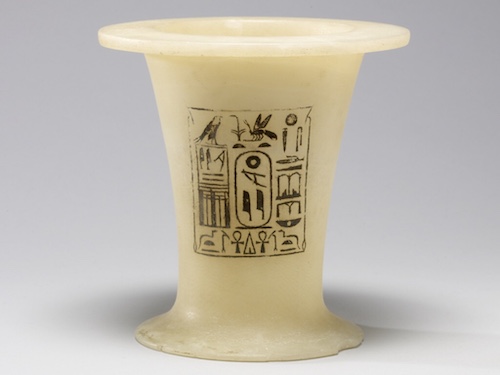
The beautiful hieroglyphs on this vessel identify its owner and the ritual in which it was used. On the left is King Pepi I's Horus name (one of a king's five names), “Beloved of the Two Lands [Egypt].” At center is his throne name, Mery-re; below are brief, symmetrical texts reading, “given life and dominion forever.” On the right is a text, “First day of the Sed-festival.”
Feast of the Tail
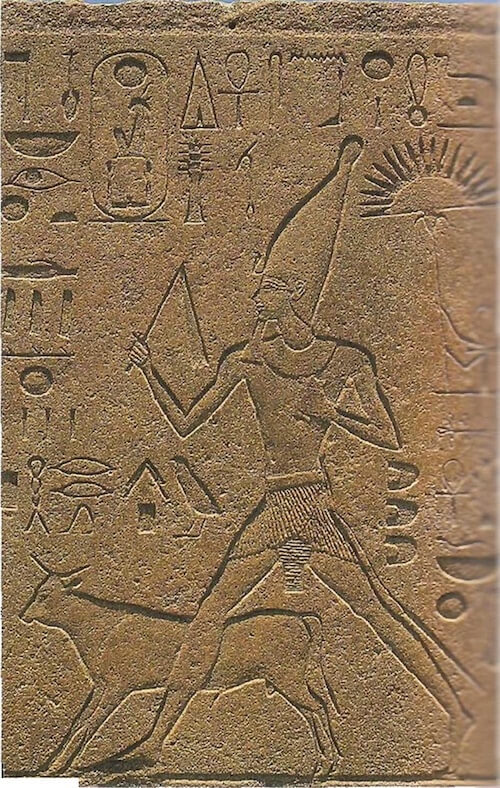
The king was then attired a short kilt with a bull's tail in its back, which probably gave the festival a less formal name: “The Feast of the Tail”. In the open space between the two rows of shrines, the king ran a ritual race alongside the Apis Bull four times as the ruler of Lower Egypt wearing the Red Crown, and four times as that of Upper Egypt wearing the White Crown. The course was bounded by two points symbolizing the borders of Egypt to reinforce his dominion over the whole kingdom, and at the same time he dedicates it to the gods. In doing so, he proved that he was still physically able to rule the country, and was thus rejuvenated and reborn. At Karnak there are blocks from the reconstructed Red Chapel that show Queen Hatshepsut as pharaoh, running with the Apis bull between the markers. Hatshepsut (18th Dynasty) held her first jubilee during her 16th regnal year, as she counted her 4 years of co-regency with Thuthmose II (her husband and the preceding king) and the 7 years co-regency with his son Thuthmose III. She thus marked the 30 years count since the death of her father, Thutmose I, from whom she derived all of her legitimacy to rule Egypt. The festival was commemorated at Karnak, where blocks from the reconstructed Red Chapel show her as king, and running with the Apis bull between the markers.
Djed Pillar
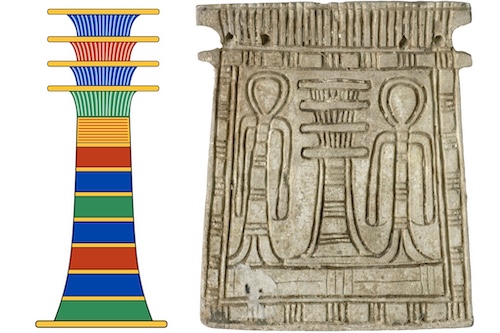
The djed symbol is one of the more ancient and commonly found symbols in Egyptian mythology. It is a pillar-like symbol in hieroglyphics representing stability. It is associated with the Creator god Ptah and Osiris, the Egyptian god of the afterlife, the underworld, and the dead. It is commonly understood to represent the spine of Osirus. According to Egyptian mythology, Osiris was the god of the afterlife. While visiting Set, the god of disorder, desert, storms, and violence, Osiris was tricked into climbing into a coffin that was built exactly to his size. He was quickly suffocated, and the coffin was cast into the Nile. Eventually, the coffin washed up on the shores of Byblos, in Syria. A sacred tree grew rapidly around the coffin, encasing the coffin within its trunk. The king of the land, unaware of the presence of the coffin, was in awe of the tree’s quick growth, and he ordered it cut down to become a pillar in his palace. All the while, Osiris’ wife Isis had been searching for him. She came to learn that his body was contained inside the pillar. She became close with the king and queen, and when they granted her a wish, she requested the pillar. Upon being granted the pillar, she removed Osiris’ body, and consecrated the pillar. It has since been called the pillar of the djed.
Raising the Djed Pillar




Raising The Djed Pillar” was an important part of the Heb Sed ceremony that started during the beginning of the 12th Dynasty (or perhaps as early as the 6th) to represent Osiris's triumph over Set. The pillar stood on a shrine, and with the help of the priests, the king would raise a wooden djed column using ropes. Offerings were presented before the pillar and below the ropes, and re-enactments of the myth of Osiris and Isis were performed. Later, a poem describing Isis and Nephthys' search for Osiris was added to the ceremony. Seti I only ruled fifteen years so this ceremony was not part of the Heb Sed ceremony. The act of raising the djed has been explained as representing Osiris's triumph over Set. The ceremony took place annually during the period when fields were sown and the year's agricultural season would begin corresponding to the month of Choiak, the fourth month of the Nile inundation season called akhet. This ceremony was a part of one of the more popular holidays and celebrations of the time, a larger festival dedicated to Osiris conducted from the 13-30th day of the Choiak month. The festival of the raising of the djed also involved re-enactments conducted at Denderah, Edfu, Busiris, Memphis, and Philae. But the most elaborate and grand celebration occurred at Abydos, the cult center of Osiris.
Ramesses II and Seti I


You may wonder why an image of Ramesses II is portrayed in the Mortuary temple of Seti I. Seti I was the father of Rammeses II and the son of Rammeses I. Rammeses I had a short reign and Seti I ruled for only 15 years, far short of the 30 years required for the Heb Sed festival. A funerary temple for Seti was constructed in what is now known as Qurna (Mortuary Temple of Seti I), on the west bank of the Nile at Thebes while the magnificent temple made of white limestone at Abydos featuring exquisite relief scenes was started by Seti, and later completed by his son Ramesses II. The image of a young Ramesses II lassoing a bull with his father Seti I has nothing to do with the Sed festival but I included it because it is a beautiful and famous image. Ramses II (19th Dynasty), who reigned for 67 years, celebrated 13 or 14 festivals, as he often left 2 instead of 3 years between his Heb Seds. Pharaohs who did not reign that long had to be content with promises of “millions of jubilees” in the afterlife.
Procession to the Chapels of the Gods




Finally, the pharaoh was carried in a procession to visit the chapels of the gods. He was carried first as king of Lower Egypt by the “Great Ones of Upper and Lower Egypt” to the chapel of Horus (temple of Seti I Abydos), where he receives the crook and the flail. Next, as king of Upper Egypt, he was carried to the two chapels of Horus of Edfu and Seth of Ombos (Ombos at Oxyrhynchus, now gone), where he was handed a bow and arrow, with which he shoots an arrow in each one of the four directions. With the conclusion of the Heb Sed, a long stretch of no less than ten days of festivals, rituals and ceremonies were over. With the most central theme of all the rituals in the Heb Sed, the renewal of the social order with the king as ruler, his power of kingship was confirmed.
Heb Sed Examples



Sed festivals implied elaborate temple rituals and included processions, offerings, and such acts of religious devotion as the ceremonial raising of a djed, the base or sacrum of a bovine spine, a phallic symbol representing the strength, “potency and duration of the pharaoh's rule”. One of the earliest Sed festivals for which we have substantial evidence is that of the Sixth Dynasty pharaoh Pepi I Meryre in the South Saqqara Stone Annal document. The most lavish, judging by surviving inscriptions, were those of Ramesses II and Amenhotep III. Sed festivals still were celebrated by the later Libyan-era kings such as Shoshenq III, Shoshenq V, Osorkon I, who had his second Heb Sed in his 33rd year, and Osorkon II, who constructed a massive temple at Bubastis complete with a red granite gateway decorated with scenes of this jubilee to commemorate his own Heb Sed.
For over three thousand years the Sed Festival provided continuity and regeneration to the ancient Egyptian Pharaohs. Now, when you recognize the “HebSed glyph” in a temple or museum, you will understand it's significance. As always, I hope you enjoyed the post, please leave a comment.
References:
Heb Sed Festival: http://m.touregypt.net/featurestories/sedfestival.htm
Jubilee Pavilion: http://broom02.revolvy.com/main/index.php?s=Jubilee%20Pavilion%20(hieroglyph)
Jubilee Hieroglyph: http://www.medu.ipetisut.com/index.php?og=jubilee
Hieroglyphs of Stone and Earthenware: http://www.afrostyly.com/gardiner/list/w/
Sed Heb Ritual: http://www.arabworldbooks.com/egyptomania/sameh_arab_sed_heb.htm
Origin of Orders: http://architecturalwatercolors.blogspot.com/2011/11/origin-of-orders-1-egypt.html
Djed Pillar: http://www.pyramidofman.com/Djed/
Dude Pillar: http://www.ancient-origins.net/myths-legends-africa/sacred-symbol-djed-pillar-002325
Set Giving Life to Horus: http://www.joanannlansberry.com/art/set-tosn.html
Oxyrhynchus Online: http://www.papyrology.ox.ac.uk/POxy/

